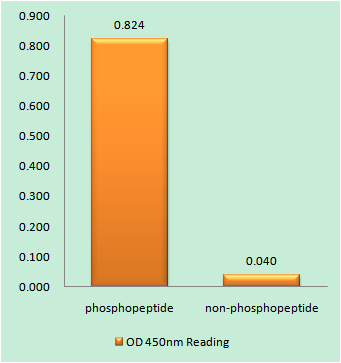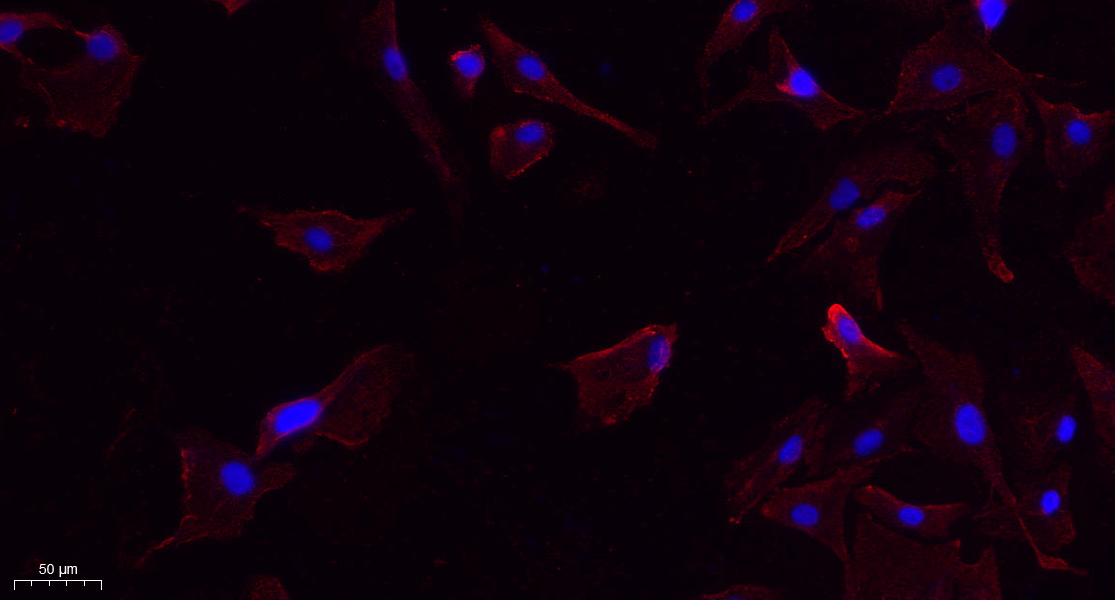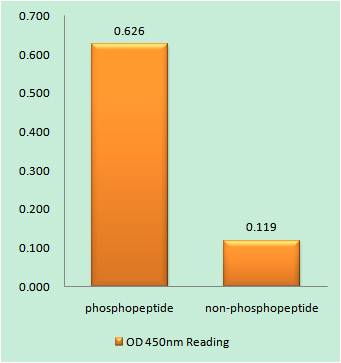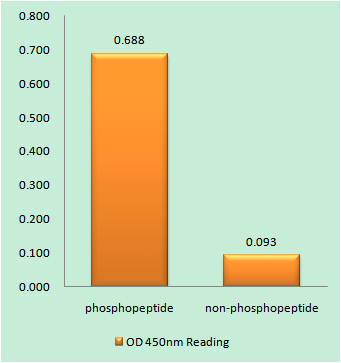
Catalog: KA1299C
Size
Price
Status
Qty.
96well
$470.00
In stock
0
Add to cart


Collected


Collect
Main Information
Reactivity
Human, Mouse, Rat
Applications
ELISA
Conjugate/Modification
Phospho
Detailed Information
Storage
2-8°C/6 months,Ship by ice bag
Modification
Phospho
Detection Method
Colorimetric
Related Products
Antigen&Target Information
Gene Name:
LCK
show all
Other Name:
LCK ;
Tyrosine-protein kinase Lck ;
Leukocyte C-terminal Src kinase ;
LSK ;
Lymphocyte cell-specific protein-tyrosine kinase ;
Protein YT16 ;
Proto-oncogene Lck ;
T cell-specific protein-tyrosine kinase ;
p56-LCK
Tyrosine-protein kinase Lck ;
Leukocyte C-terminal Src kinase ;
LSK ;
Lymphocyte cell-specific protein-tyrosine kinase ;
Protein YT16 ;
Proto-oncogene Lck ;
T cell-specific protein-tyrosine kinase ;
p56-LCK
show all
Database Link:
Background:
catalytic activity:ATP + a [protein]-L-tyrosine = ADP + a [protein]-L-tyrosine phosphate.,disease:A chromosomal aberration involving LCK is found in leukemias. Translocation t(1;7)(p34;q34) with TCRB.,domain:The SH2 domain mediates interaction with SQSTM1. Interaction is regulated by Ser-59 phosphorylation.,enzyme regulation:Inhibited by tyrosine phosphorylation.,function:Tyrosine kinase that plays an essential role for the selection and maturation of developing T-cell in the thymus and in mature T-cell function. Is constitutively associated with the cytoplasmic portions of the CD4 and CD8 surface receptors and plays a key role in T-cell antigen receptor(TCR)-linked signal transduction pathways. Association of the TCR with a peptide antigen-bound MHC complex facilitates the interaction of CD4 and CD8 with MHC class II and class I molecules, respectively, and thereby recruits the associated LCK to the vicinity of the TCR/CD3 complex. LCK then phosphorylates tyrosines residues within the immunoreceptor tyrosines-based activation motifs (ITAMs) in the cytoplasmic tails of the TCRgamma chains and CD3 subunits, initiating the TCR/CD3 signaling pathway. In addition, contributes to signaling by other receptor molecules. Associates directly with the cytoplasmic tail of CD2, and upon engagement of the CD2 molecule, LCK undergoes hyperphosphorylation and activation. Also plays a role in the IL2 receptor-linked signaling pathway that controls T-cell proliferative response. Binding of IL2 to its receptor results in increased activity of LCK. Is expressed at all stages of thymocyte development and is required for the regulation of maturation events that are governed by both pre-TCR and mature alpha beta TCR.,mass spectrometry: PubMed:11840567,online information:Lck entry,PTM:Phosphorylated on Tyr-394, which increases enzymatic activity (By similarity). Phosphorylated on Tyr-505, which decreases activity.,similarity:Belongs to the protein kinase superfamily. Tyr protein kinase family. SRC subfamily.,similarity:Contains 1 protein kinase domain.,similarity:Contains 1 SH2 domain.,similarity:Contains 1 SH3 domain.,subcellular location:Present in lipid rafts in an unactive form.,subunit:Binds to the cytoplasmic domain of cell surface receptors, such as CD2, CD4, CD5, CD8, CD44, CD45 and CD122. Also binds to effector molecules, such as PI4K, VAV1, RASA1, FYB and to other protein kinases including CDC2, RAF1, ZAP70 and SYK. Binds to phosphatidylinositol 3'-kinase (PI3K) from T-lymphocytes through its SH3 domain and to the tyrosine phosphorylated form of KHDRBS1/p70 through its SH2 domain. Binds to HIV-1 Nef through its SH3 domain. This interaction inhibits its tyrosine-kinase activity. Interacts with SQSTM1. Interacts with phosphorylated LIME1. Interacts with CBLB and PTPRH.,tissue specificity:Expressed specifically in lymphoid cells.,
show all
Function:
cell activation, immune system development, leukocyte differentiation, positive regulation of immune system process,regulation of leukocyte activation, positive regulation of leukocyte activation, protein amino acid phosphorylation,phosphorus metabolic process, phosphate metabolic process, ion transport, cation transport, calcium ion transport,cellular ion homeostasis, cellular calcium ion homeostasis, cellular metal ion homeostasis, cellular zinc ion homeostasis,apoptosis, induction of apoptosis, activation of caspase activity, cell surface receptor linked signal transduction,elevation of cytosolic calcium ion concentration, cell death, positive regulation of signal transduction, positive regulation of cell communication, regulation of cell death, positive regulation of cell death, positive regulation of peptidase activity, programmed cell death, induction of programmed cell death, di-, tri-valent inorganic cation transport, death, phosphorylation, cellular homeostasis, metal ion transport, cellular cation homeostasis, cellular di-, tri-valent inorganic cation homeostasis, hemopoiesis, lymphocyte differentiation, T cell differentiation, regulation of homeostatic process, T cell activation, response to drug, homeostatic process, regulation of apoptosis, positive regulation of apoptosis, regulation of programmed cell death, positive regulation of programmed cell death, positive regulation of catalytic activity, positive regulation of caspase activity, regulation of caspase activity, positive regulation of molecular function, leukocyte activation, lymphocyte activation, hemopoietic or lymphoid organ development,chemical homeostasis, ion homeostasis, regulation of antigen receptor-mediated signaling pathway, regulation of T cell receptor signaling pathway, positive regulation of antigen receptor-mediated signaling pathway, positive regulation of T cell receptor signaling pathway, regulation of T cell activation, regulation of cell activation, positive regulation of cell activation, positive regulation of T cell activation, release of sequestered calcium ion into cytosol,regulation of lymphocyte activation, positive regulation of lymphocyte activation, regulation of sequestering of calcium ion, negative regulation of sequestering of calcium ion, regulation of hydrolase activity, positive regulation of hydrolase activity, cytosolic calcium ion homeostasis, regulation of peptidase activity, regulation of endopeptidase activity, metal ion homeostasis, di-, tri-valent inorganic cation homeostasis, zinc ion homeostasis, calcium ion homeostasis, cation homeostasis, cellular chemical homeostasis, cytosolic calcium ion transport, calcium ion transport into cytosol,
show all
Cellular Localization:
Cell membrane ; Lipid-anchor ; Cytoplasmic side . Cytoplasm, cytosol . Present in lipid rafts in an inactive form. .
show all
Tissue Expression:
Signaling Pathway
Organismal Systems >> Immune system >> Natural killer cell mediated cytotoxicity
Organismal Systems >> Immune system >> T cell receptor signaling pathway
Organismal Systems >> Immune system >> Th1 and Th2 cell differentiation
Organismal Systems >> Immune system >> Th17 cell differentiation
Organismal Systems >> Development and regeneration >> Osteoclast differentiation
Human Diseases >> Cancer: overview >> PD-L1 expression and PD-1 checkpoint pathway in cancer
Human Diseases >> Immune disease >> Primary immunodeficiency
Environmental Information Processing >> Signal transduction >> NF-kappa B signaling pathway
Reference Citation({{totalcount}})
Catalog: KA1299C
Size
Price
Status
Qty.
96well
$470.00
In stock
0
Add to cart


Collected


Collect
Recently Viewed Products
Clear allPRODUCTS
CUSTOMIZED
ABOUT US
Toggle night Mode
{{pinfoXq.title || ''}}
Catalog: {{pinfoXq.catalog || ''}}
Filter:
All
{{item.name}}
{{pinfo.title}}
-{{pinfo.catalog}}
Main Information
Target
{{pinfo.target}}
Reactivity
{{pinfo.react}}
Applications
{{pinfo.applicat}}
Conjugate/Modification
{{pinfo.coupling}}/{{pinfo.modific}}
MW (kDa)
{{pinfo.mwcalc}}
Host Species
{{pinfo.hostspec}}
Isotype
{{pinfo.isotype}}
Product {{index}}/{{pcount}}
Prev
Next
{{pvTitle}}
Scroll wheel zooms the picture
{{pvDescr}}




















